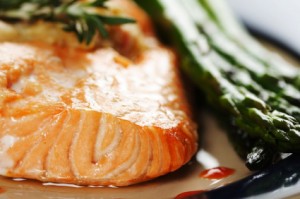Salmon Benefits and Risks
Get the basics on salmon benefits and risks. Learn shopping and dining tips for maximizing salmon’s benefits and minimizing any potential risks.
Salmon Benefits and Risks
But after a study published in Science reported that some varieties of farmed salmon contained high levels of cancer-causing chemicals called PCBs, some people have shied away from farmed varieties. (More than 80% of the fresh salmon eaten in the U.S. is farmed.) The PCBs come from the fish meal and fish oil the salmon are fed.
The good news: The global salmon farming industry is investigating ways to reduce PCB levels by using alternative food sources like soybean oil.
In the meantime, there’s much you can do. When grocery shopping or dining out, ask for wild-caught salmon.
If all that’s available is farmed salmon, remove the skin and the layer of fat just beneath the skin before or after cooking because these are the two places where the chemicals tend to concentrate. When dining out, ask the chef to do the same if the salmon served is farmed.
Most importantly, do buy salmon and other fish rich in omega-3 fatty acids, like herring, mussels, sardines (water-packed, without salt), trout, mackerel (North Atlantic and Pacific varieties) and whitefish. Overall, they’re much better choices than beef, pork, lamb, and even chicken, all of which contain artery-clogging saturated fat.
And very modest amounts of omega-3-rich fish like salmon – just two to three servings a week – deliver loads of health benefits, especially for your heart.
All in all, salmon benefits and risks add up to many more benefits compared to risks.
